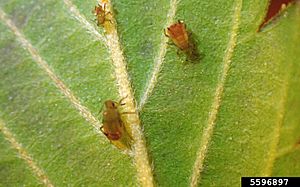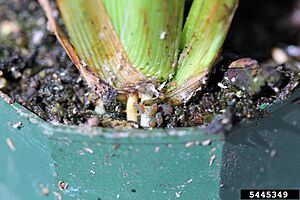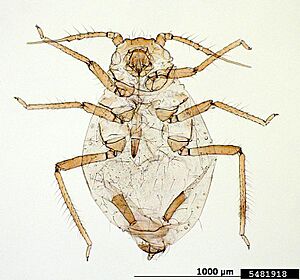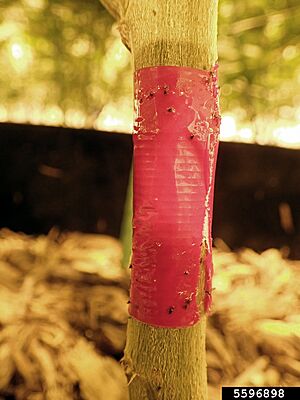Rice root aphid facts for kids
Quick facts for kids Rice root aphid |
|
|---|---|
 |
|
| Nymphs on the underside of a leaf | |
| Scientific classification | |
| Genus: |
Rhopalosiphum
|
| Species: |
rufiabdominale
|
| Synonyms | |
|
|
The Rhopalosiphum rufiabdominale, also known as the rice root aphid, is a tiny insect that feeds on plant sap. It is a common pest found all over the world. This aphid belongs to a group of insects called Aphids.
Adult and young aphids are soft-bodied. They are usually dark green, but can also have brown, red, or yellow colors. Like all aphids, they can reproduce in two ways: with a partner or by themselves. This depends on where they live and what plants they are on.
Rice root aphids harm plants by sucking sap from their roots or stems. They can also spread serious plant viruses. These pests can live on many different kinds of plants. They especially like plants in the Rosaceae (like roses), Poaceae (like grasses), and Solanaceae (like tomatoes) families.
This aphid is often found on Prunus trees, which include plums and cherries. It also infests many farm crops, greenhouse vegetables, and other garden plants. The rice root aphid first came from East Asia. Now, it lives on almost every continent. It has spread widely in the United States, India, and Australia. It causes damage to crops, especially rice crops in Japan. This aphid is a big concern because it moves easily, hides well, and can adapt to many places.
Contents
About the Rice Root Aphid
How to Spot Rice Root Aphids
Finding rice root aphids can be tricky at first. This is because they prefer to live in the soil or growing material. However, they can also infest plants grown in water systems like hydroponics and aeroponics. You might not know your plants have them unless you carefully check the roots. Sometimes, you might see winged adults above the ground.
In hydroponic systems, watering can bring the aphids to the surface for a short time. This makes them easier to see. If your plants look yellow or stop growing, you might think they need more nutrients. If they wilt, you might think they are sick. But these can also be signs of aphids.
As more aphids appear, winged adults can fly out of the soil. They then move to other plants. Sticky traps can be a good way to find them early. Ants often live with aphids because they like the sweet liquid called honeydew that aphids make. So, if you see many ants on your plants, it could mean aphids are nearby.
What They Look Like
Adult rice root aphids are about 1.4 to 2.4 millimeters long. They have a soft, rounded body. You can tell them apart from a similar aphid, Rhopalosiphum padi, by their five antenna parts. They also have more tiny hairs called setae.
Aphids without wings can be dark green to brown. They might have yellow or red colors. Winged aphids are usually darker. Both types have a bluish-white waxy band across their back. Their legs, cornicles (small tubes on their back), and cauda (a tail-like part) are darker than the rest of their body. The hairs on their body are short and thick. The hairs on their five-part antennae are longer. The cornicles are short and a bit swollen at the tips.
Life Cycle and Reproduction
Most of the rice root aphid's life happens underground. Only winged adults come out of the soil to find new plants. In their home region, these aphids have a special life cycle. They spend fall and winter on Prunus trees, like plum or cherry. For the rest of the year, they live on the roots of other herbaceous plants.
In warmer places or in greenhouses, they often reproduce without a partner. This is called parthenogenesis. The females give birth to baby aphids that are exactly like them. These young aphids grow up in less than ten days. As adults, they can live for up to thirty days and have babies every day. If conditions are perfect, like at 23 degrees Celsius, a new generation can appear every seven days. Their numbers can double in less than two days. They can also lay eggs that survive the winter until the weather gets better.
Even though they prefer to be underground, winged adults can stay on plant parts above ground for weeks. Rice root aphids have a mouthpart that works like a straw. They use it to suck sap from the plant's food tubes, called phloem. Both young and adult aphids feed on plants at any stage of growth. However, they can only live for a few days without a host plant.
Where They Live and What They Eat
Global Distribution
The rice root aphid started in a region called the Palearctic realm. Now, it is found all over the world. It lives in almost every land habitat, except Antarctica. From Japan, it has moved across Asia and Oceania. It is now found in over fifty countries. In these places, it can be a minor or major pest.
It has been in North America for over a hundred years. You can find it across Canada and the United States. In the U.S., it is very common and has been found in nearly half of the states. It has also spread to seven countries in Africa and South America, and three in Europe. These countries, especially those with large farms or gardens, have had problems with this pest.
Plants They Infest
R. rufiabdominale is a species that eats many different kinds of plants. It can be found on plants from twenty-two different plant families. Most of its favorite plants belong to these families: Rosaceae, Poaceae, Cyperaceae, Solanaceae, Cannabaceae, Pinaceae, or Cucurbitaceae. In Europe, it has also been found on plants from the Araceae, Asteraceae, and Ranunculaceae families.
Research shows they can infest many plants with two seed leaves (dicotyledonous plants). However, they mostly prefer plants with one seed leaf (monocotyledons). This is similar to their close relatives, R. maidis and R. padi. This is especially true for plants in the Poaceae family, which includes grasses. Here are some of the main plants they infest:
- Farm crops like cereals, grains, and grasses: rice, barley, wheat, oats, millet, sorghum, cotton, sugarcane, and tobacco.
- Vegetable crops: aubergine (eggplant), tomato, pepper, potato, corn, cauliflower, celery, and squash.
- Ornamental plants and fruit trees: Prunus spp. (17 types of stone fruit and ornamental trees and shrubs), grasses, Dieffenbachia spp., and irises.
- Other plants: sedge, and forestry trees.
- Primary hosts are shown in bold.
Impact on Plants
How They Damage Plants
Adult and young aphids feed on the roots and sometimes the stem of plants. They suck the plant's sap, which makes the plant lose its strength. The parts where they feed can change color. Leaves or stems might turn yellow or pale. Plants can also look dry, twisted, or form tight clusters of leaves. If there are many aphids, the whole plant can wilt and even die.
In rice plants, it is well known that aphid damage causes leaves to turn yellow and growth to slow down. Very bad infestations can cause wilting and plant death. Aphids also produce honeydew, a sticky substance. This honeydew can lead to the growth of mold or fungi, called sooty mold. Underground, this might look like a light, dusty ring.
Aphids can also cause harm indirectly. When they poke their mouthparts into plants, they can transfer saliva. This can spread serious plant diseases. For example, they can spread sugar cane yellow leaf virus and barley yellow dwarf virus. In India, they have been reported to spread maize mosaic virus and sugarcane mosaic virus.
Crop Losses
Most of the information about economic losses comes from rice crops in Japan. It is reported that yields can drop by up to 50% if young rice plants are lightly fed on. The damage becomes severe when the plants start to grow new shoots. In 1990, the aphid caused major damage to a squash crop in Florida. The roots turned dark and rotted.
More recently, this pest was found causing serious damage to an organic celery crop in California. Another aphid, Hyadaphis foeniculi, was also present. Together, they caused up to 80% loss in celery yield because the plants were severely stunted. Losses due to barley yellow dwarf virus have also been reported in North America and Europe, including Turkey, where barley is a common crop.
Managing Rice Root Aphids
The best way to control rice root aphids is by using an integrated pest management system. This pest is hard to manage because it mostly lives underground. This makes it difficult to use biological control methods or sprays that go on leaves. So, finding them early by checking plants often is very important.
Also, preventing them with cultural and physical methods works best. Using helpful insects and carefully chosen natural pesticides can also help.
Physical and Cultural Control Methods
In late spring, winged adult aphids often fly to new plants in fields and greenhouses. You can use netting or screens to stop them from reaching plant roots. For eggs that stay in the soil over winter, heating the soil can kill them. However, this can also reduce helpful tiny living things in the soil.
Using clean, certified growing materials can lower the risk of bringing in aphids. It might also be good to use coarse or chipped soil instead of fine soil. Rice root aphids are known to be more common in sandy soil.
Changing crops or leaving fields empty for a while can help. This creates a time when there are no host plants for the aphids. Removing other plants and weeds, especially grassy ones, is another simple way to help. Avoiding mulched top dressings, which this pest likes, can also reduce the chance of an infestation.
Biological and Biopesticide Control Methods
For winged adult aphids, some natural enemies used for other aphids can be helpful. These include ladybird beetles, Aphidoletes aphidimyza (a type of fly larvae), other syrphid fly larvae, and Chrysoperla species (lacewings). Some types of Aphelinus, which are parasitic wasps, will also feed on winged adults. However, they might not be enough to control a large problem.
The only natural enemy that lives in the soil and might help is Stratiolaelaps scimitus. This tiny creature usually eats fungus gnat larvae. But it might also help control rice root aphids underground.
In the early 1990s, a fungus called Lecanicillium lecanii was found by accident. It caused a big drop in rice root aphid numbers on squash plants. This fungus kills aphids from the inside. After trying it on other crops, it was found that this fungus could control the pest. Now, it is often used against rice root aphids.
A study in 2014 showed that natural controls like microbes and plant-based products can reduce underground pests in organic vegetable crops. Treating soil with Beauveria bassiana and azadirachtin (from neem oil) reduced aphid numbers by 62% after two treatments. Other products like Chromobacterium subtsugae and Burkholderia spp. also showed reductions. More research is needed to find the best ways to use these products.
Another way to use these products is as a dip for new plants. Plants brought into growing facilities can be treated with insecticidal soap or Beauveria bassiana.
Chemical Control Methods
In the past, special insecticides that spread through the plant were used to control this pest. However, these products are used less often now. This is because aphids can become resistant to them. Also, there are worries about these chemicals staying in the soil and water, building up in the food chain, and harming helpful insects.
Many of these pesticides are now banned. This includes endosulfan, which was one of the few chemicals known to work well against rice root aphids. Carbofuran, another chemical soil treatment, was once thought to be useful. But it is now known to be very harmful to the environment and other living things. Because there are few chemical products left, and more might be banned, this method is not a good choice for controlling rice root aphids anymore.




